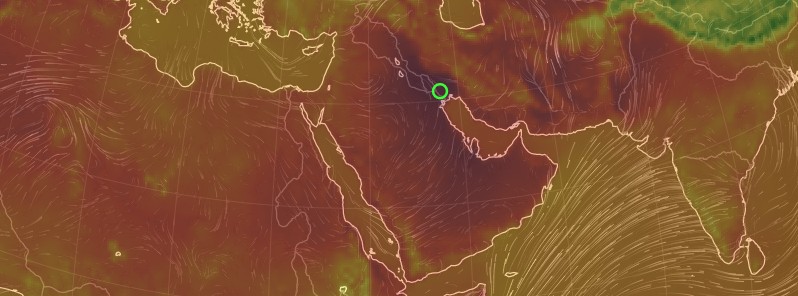Middle East breaks all-time maximum temperature records with 54 °C (129.2 °F)

Maximum daily temperatures across much of the Middle East have reached extreme levels this week, with numerous all-time records broken. On July 21, Kuwait has set the 'most reliable' eastern hemisphere's all-time maximum temperature record at 54 °C (129.2 °F) and challenged the official world record for highest recorded temperature, set in California's Death Valley in July 1913.
On Thursday, July 21, 2016, a weather station located in Mitribah, a remote featureless area of north-west Kuwait measured a record-breaking, maximum daily temperature of 54 °C (129.2 °F).
This measurement is still not officially verified by the World Meteorological Organisation (WMO), although it most likely will. If it does, this would be Earth's hottest temperature ever reliably measured outside of Death Valley, California, Wunderground's weather historian Christopher Burt said. July 21 was a historic day in the annals of meteorology, Wunderground's meteorologist Jeff Masters added.
The Death Valley comparison is important because its Furnace Creek Ranch station holds the official world record for the highest recorded temperature. This station registered 56.7 °C (134.1 °F) on July 10, 1913, but this measurement is now being challenged as the records, apparently, show nearby places were nowhere near as hot and the wind conditions were not favorable for such high temperatures. The same station, however, officially registered 54 °C (129.2 °F) on June 30, 2013, the same as Kuwait's Mitribah on July 21, 2016.
For many years, world's highest recorded temperature was officially 58 °C (136.4 °F), measured in El Azizia, Libya in 1922. This record was disqualified by the WMO in 2012 in favor of Death Valley's 56.7 °C (134.1 °F) from 1913.
The maximum daily temperature in Mitribah passed 50 °C (122 °F) on July 18, and remained above through July 24. Similar temperatures were recorded across the Middle East.
Basra International Airport in Iraq, for example, recorded a maximum temperature of 50.8 C (123.4 °F) on Wednesday, July 20. The temperatures continued rising and on July 21, the station recorded 53.9 °C (129 °F), breaking all previous records. It is important to note here that this station is located within an international airport.
Saturday, July 23, brought noticeable 6 °C (10.8 °F) lower maximum temperature to Basra, 47.6 °C (117.8 °F), but Mitribah remained extremely hot, with a maximum temperature of 53.1 °C (127.5 °F). At 06:00 UTC on Sunday, July 24 (09:00 local time), Mitribah was already baking at 40.6 °C (105.1 °F).
Thursday's Basra reading ranks as the fourth highest temperature ever reliably measured outside of Death Valley, according to Burt. "The only higher non-Death Valley temperatures were Thursday's 54 °C (129.2 °F) at Mitribah, Kuwait, a 53.6 °C (128.5 °F) reading at Sulaibya, Kuwait in 2011, and a 53.5°C (128.3 °F) reading at Mohenjodaro, Pakistan on May 26, 2010."
Masters noted there is one other competitor for hottest non-Death Valley temperature ever measured – the all-time maximum temperature record for Israel. On June 22, 1942, Israel's weather station in Tirat Tsvi recorded 54 °C (129.2 °F), but the measurement is now also being challenged. However, after a WMO-initiated investigation, Israel Met Department confirmed the data is correct and still holds it as official maximum recorded temperature for the country.
Although these are all extremely high temperatures, Middle East is usually a very hot place during late July. The average maximum temperature at both Mitribah and Basrah for this time of year is 46.1 °C (115 °F).
This current heat is a result of the massive ridge of high pressure aloft (bulge in the jet stream) centered over Iraq, Iran, and Kuwait. With high pressure, the air sinks and warms, and it's keeping the already hot air at the surface in place.
The ridge has now started weakening and the temperatures are dropping, but highs are still expected near 48.9 °C (120 °F).
Featured image: Surface temperature + winds at 12:00 UTC on July 21, 2016. Credit: EarthNullSchool

Commenting rules and guidelines
We value the thoughts and opinions of our readers and welcome healthy discussions on our website. In order to maintain a respectful and positive community, we ask that all commenters follow these rules:
We reserve the right to remove any comments that violate these rules. By commenting on our website, you agree to abide by these guidelines. Thank you for helping to create a positive and welcoming environment for all.